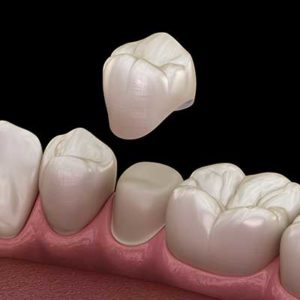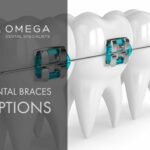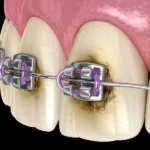What is Hypodontia?

The human mouth is designed to hold a total of 32 permanent teeth. However, some disturbances during the early stages of tooth formation may result in congenital absence of one or more teeth. The medical term that is used to describe the congenital absence of less than six permanent teeth (other than the third molars) is hypodontia. Where a patient is missing 6 or more teeth, the condition is termed as oligodontia. Finally, the term anodontia is used to describe the condition where the patient has no teeth. While the thought of missing teeth may look bizarre to some, hypodontia is the most common anomaly for dental development in humans affecting between 1.6 to 6.9%, of people.
Table of Contents
What Are The Causes Of Hypodontia?
There are a few causes of hypodontia that doctors are aware of. The first cause is genetics. Studies have shown that the occurrence of hypodontia is correlated with more than 120 genetic syndromes, such as cleft lip and palate, Down syndrome, hereditary ectodermal dysplasia, and ectodermal dysplasia. The second cause of hypodontia is exposure to certain drugs, PCBs, and radiation during pregnancy. Such drugs include anticancer chemotherapy agents and other drugs that are used to treat toxic epidermal necrolysis. The third known cause of lack of teeth is hormonal defects. Finally, scientists have found out that children with low birth weight (especially twins) are at a higher risk of hypodontia.
How Would You Know If Your Child Has Hypodontia?
The main sign for hypodontia are gaps that are left between teeth after the development of permanent teeth. In other cases, the teeth might be present, but maybe small in size or appear pointed. An examination by a dentist using an x-ray is needed for proper diagnosis.
Can Hypodontia be prevented?
Hypodontia is a genetic condition that runs in families. However, people who are affected by conditions do not always transfer it to their children. Studies show that exposure to some drugs and radiation may be associated with the occurrence of hypodontia. Despite this, there are no known ways to prevent it from occurring because it is genetic. However, hypodontia can be cured using some orthodontic treatment options.
What Are The Treatment Options For Retained Primary Teeth?
There are four treatment options available for you if your child has hypodontia:
1. Retain the teeth as they are
No orthodontic treatment is necessary if the dentist finds that your child’s teeth are functionally and aesthetically acceptable. Retaining the teeth as they are is the best option in this case because it eliminates the need for unnecessary lengthy and costly treatment.
2. Retain and modify the teeth
In some cases, the teeth may be structurally sound but need minor aesthetic improvement. The dentist may propose the use of permanent removable braces or other orthodontic treatment methods depending on the objectives they want to achieve.
3. Extract the Teeth and Close Spaces
Extraction is necessary where there is overcrowding. The orthodontist will then fit the patient with braces to close the gap left by the teeth that they have removed. If gaps are still left when the braces are removed, they may fill them to achieve the best aesthetic look.
4. Extract and give prosthetics.
If the patients are diagnosed with dental caries, root resorption, periapical disease, or teeth with an inadequate aesthetic condition, the dentist may choose to remove any teeth left in the mouth and replace them with prosthetic teeth.
What Are The Prosthetic Replacements Available for Hypodontia?
Hypodontia is a congenital absence of one or more teeth. While there is no way to make new teeth to grow to make up for any teeth that you are missing, there are several ways to improve the appearance of people with missing teeth.
1. Use Of Braces
People with only two missing teeth are the easiest to treat using orthodontic treatments. Braces can be used to shift the remaining teeth to fill the gaps left by the missing teeth. Any gaps that are left after orthodontic treatment can be filled to achieve a uniform and aesthetically pleasing look.
2. Dental Implants
People who are missing more teeth need a dental implant. The dental implant will be inserted by placing a metal root inside the jawbone. A crown that is fabricated to look the same as your teeth will then be attached to the exposed part of the implant. If the missing teeth are far apart, an implant will have to be put in each of the areas where you are missing teeth. However, if you need a full set of teeth, the orthodontist will implant all of them using only four dental implants per jaw.
3. A Bridge
A bridge is the other permanent method of treating hypodontia. Like the name suggests, a bridge is a false tooth that joins the gap between two permanent teeth. Bridges are made of r porcelain fused to either metal or ceramics. Bridges are an inexpensive solution that can help you restore your smile, and in your bite by replacing missing teeth and prevent other teeth from drifting out of position.
3. Dentures
Dentures are removable plates with teeth attached to them. Children can start wearing dentures to give them a dentition that is similar to their peers to enhance their self-esteem and assist in speech development. However, children’s dentures need to be replaced periodically to match the changes in the child’s jaws as they grow. Dentures can be a permanent fix to hypodontia or used until the child is old enough to get permanent teeth implants.
How Soon Should You Start Treatment?
Timing is everything when dealing with hypodontia. Once you notice that your child has some gaps when they start to develop permanent teeth, you should visit a dentist to discuss the options available to your child. Upon inspection, the dentist should be in a position to give you a treatment plan or advise you to see an orthodontist if special attention is required. If your child is missing only two teeth, the dentist should be able to monitor the child’s progress and install a brace or a dental implant at the right time. However, if your child is missing a lot of teeth, it is best to see a specialist. Regardless of the severity of the problem, timely intervention is important because some orthodontic treatments like braces are more effective at a young age.
-
February 15, 2023What Is The Average Cost Of Braces In Houston?
-
February 01, 2023What You Need to Know About Dental Hygienists?
-
January 30, 2023What to Expect During the Wisdom Teeth Extraction
-
October 23, 2022Wisdom Tooth Removal Cost
-
October 23, 2022Dental Emergency, Open Saturday
-
October 23, 2022Full Guide to Dental Crown
-
July 26, 2022Should I Have My Wisdom Teeth Removed Before I Get Braces?
-
July 26, 2022Complete Guide to Wisdom Tooth Removal





